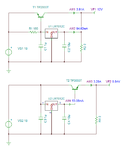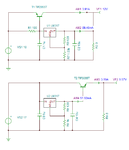Enzy
Advanced Member level 1
I built this circuit and for some reason the output transistor keeps getting hot.
the load is a tv which requires 12v @ 4 amps and the supply can supply 4.5v to 15v dc at 5amps

here is the schematic
based on my testing the tv is pulling 1.5amps when its loaded though the voltage pulls down from about 12,2v to about 9.8v but its only pulling 1.5amps.
the voltage regulator stays kool so I dont know if its something thats wrong with the design.
the load is a tv which requires 12v @ 4 amps and the supply can supply 4.5v to 15v dc at 5amps

here is the schematic
based on my testing the tv is pulling 1.5amps when its loaded though the voltage pulls down from about 12,2v to about 9.8v but its only pulling 1.5amps.
the voltage regulator stays kool so I dont know if its something thats wrong with the design.



